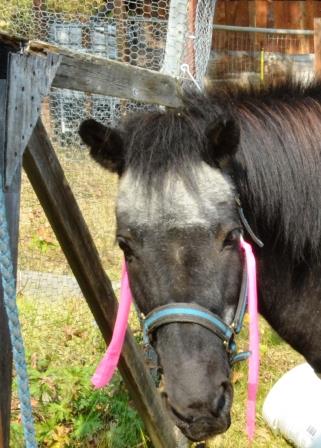
Home > Dispatches > Daily Dispatches 2019 >Daily Dispatch #251
September 11, 2019: Tinni fra Hellistandi
I acquired Tinni from Katelyn Barnett 11 years ago. She, who was then 18, was first going to Iceland and then to college and needed to find him a good home. I was needing another horse because neither Raudi nor Siggi were yet of riding age, and I was a very green rider. It turned out that this was a wise choice. Tinni was a very reliable trail horse, and he upped my level of confidence and riding ability. And when the other two became of riding age, I still routinely first rode Tinni in order to check out the trails. One day I went riding with a young friend. Her horse stumbled into a bog. I left Tinni by the trail as we worked to extract her horse. After we freed her mare, I noticed that Tinni was gone. The question was where – we were seven miles from home and had taken a circuitous route to get to where we were. Oh oh. The only thing I could do was head home and hope for the best. |
|
I arrived home a couple of hours later, and there Tinni was at the driveway gate, quietly grazing. I deduced that he felt like the area he was in was unsafe and therefore decided to act accordingly. Pete began riding Tinni after Siggi passed on. He and Tinni did quite well in local Competitive Trail Rides, their first year taking first in all the novice categories and the following year taking first in all the competitive trail divisions. The judge said about Tinni’s horsemanship score “Tinni is an ideal trail horse. He does as he’s asked and in a nice, polite fashion.” Tinni is now visibly gray. He came with heaves so early on, I began soaking his hay. I’ve also have always made sure the horse shelters are dust free. Yes, I use a shop vacuum. This summer, when we were on our trip, Alaska experienced extreme heat and smoke, from area fires. We retrieved Tinni the day we got back from our trek. He was coughing badly and moving very slowly. I resumed soaking his hay and putting him on joint supplements. I resumed taking him for long walks, and when he was better, began ponying him off Raudi. Our routine also included the use of TTouches and body wraps, and acupressure. We used to have Tinni shod, but barefoot clinician Pete Ramey noted that there was some hoof wall separation occurring, so we went barefoot and began coating his soles with hoof armor. We trim at four week intervals, and our farrier trims at eight week intervals. Finally, we began putting him in his own enclosure, one with a gate that is now open in the daytime. This way, he can go in and out into the yard when he chooses. I think that Tinni is most appreciative of the care he’s been given – lately he’s been less stoic and more affectionate in the past. I’m a returning rider – I resumed riding in 2000, and took lessons in Butte, Montana. We moved to Alaska in 2002 and I continued to take lessons. I acquired Raudhetta in 2003 and Siggi in 2004. Our herd now numbers four. Tinni’s other barn-mates include Hrimfara fra Lough Arrow II and Tyra fra Tuskast. I have changed radically over the years. In particular, my early interactions with Tinni (as hoped) have made me a more confident and centered rider. When he was younger, he tested me – if I was anxious he’d put his head up, his way of saying get with the program or I will bolt. And he would if left unattended on the trail, head for home. My interactions with older Tinni have made me a more patient and less anxious individual. I no longer fret when something is amiss – I instead just deal. I have three other horses that also need care and attention. Someone recently asked me if I was bothered by the fact that time spent tending to Tinni takes time away from the others. My response was no, absolutely not. I take great joy in being in his presence. My future plans – We did not take Tinni with us on our long treks because he has COPD and we knew we’d be spending a lot of time at higher altitudes. I very much want to again go trekking and again live a semi-nomadic lifestyle. However, these plans are now on hold. We can’t go anywhere until we find a house-sitter who is as invested in Tinni’s well-being as we are. The up side to this is that we live in a beautiful place in a beautiful area and enjoy being good land stewards. The down side is I want to be on the move again, and so do the three mares. I tell people that Tinni is primordial – especially in the winter when his thick black coat grows in. And I tell people that while I am not yet primordial, that I’m getting there. I am planning on owning, tending to, and caring for horses the rest of my life. I am obsessed with making the horse/human body awareness connection. This continues to make all horsey things possible. In this respect, Tinni remains my best teacher. |
|
